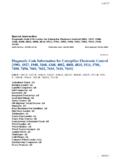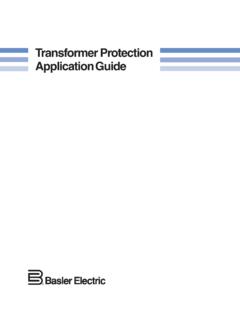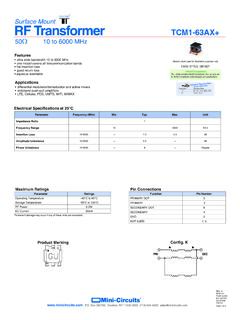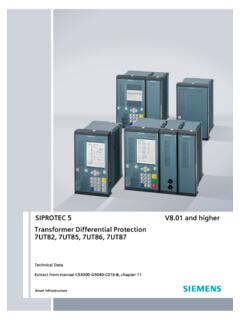Transcription of Transformer Dry Type Install Best Practices White ... - Eaton
1 Best Practices for the installation and inspection of dry-type distribution and power transformers IntroductionTransformers are often one of the most costly and critical pieces of equipment installed in a power system. In order to achieve the greatest value out of this investment, it is vital that transformers are properly installed, designed, and manufactured. Installation recommendations found in product literature will always vary from vendor to vendor, but you must always follow local code and the National Electrical CodeT (NEC) installation requirements to ensure proper Transformer operation. This paper will explore the most important aspects of dry-type distribution transformers installation and inspection in order to provide general guidelines when evaluating an existing installation or overseeing new construction. Transformer labelingWhen performing an on-site inspection of a facility, it should be a priority to verify that required codes are met for labeling to avoid personnel danger and potential penalties.
2 Dry-type transformers typically have a nameplate section in the front with exposed terminals behind the front cover. Because this is the main access point, it is usually not necessary to label the other must also mark each Transformer with the name of the manufacturer, rated kVA, primary and secondary voltage, impedance (if 25 kVA or larger), and clearances from ventilating openings. Look on the Transformer for the required clearances, as these are manufacturer s instructions and you must comply with signs of inadequate electrical products include: missing or poor-quality labels, out-of-date product codes, and absence of, or imitation, third-party testing certification labels from organizations such as Underwriters Laboratories (ULT), the Canadian Standards Association (CSAT), or other bodies that certify the quality and performance of electrical products. Low-voltage dry-type transformers typical nameplate informationThought leadership White paperPre-installation inspectionWhen installing a new Transformer , one of the most important aspects is the Transformer transformers should be inspected upon receipt before removing from cars or trucks to determine if any damage is evident or if there is any indication of rough handling.
3 A claim should be filed with the carrier at once and the manufacturer notified if damage is evident. Insulation resistance and ratio tests may be performed as part of the inspection procedure. If there is evidence of damage, an internal inspection will be required. In this inspection, note should be made of loose or broken connections, damaged or displaced parts, cracked insulators, dirt or foreign material, and evidence of free water or moisture. Corrective measures should be taken where necessary. The internal inspection of a ventilated or non-ventilated dry-type Transformer can be readily accomplished at a suitably clean and dry location on the site. Inspection prior to energizing After a Transformer is moved, or if it is stored before installation, the inspection should be repeated before placing the Transformer in service. Additionally, after the Transformer is placed in permanent position, shipping braces should be removed, and shipping bolts, if present, should be loosened or removed per manufacturer s recommendations.
4 For ventilated designs only, if moisture is evident, the unit should be dried out by placing it in an oven or by blowing heated air over it. The temperature should not exceed 110 C (230 F) to prevent damage to the Transformer s , before placing in service, check the operation of fans, motors, relays, and other auxiliary devices. Verify the selection of taps and ratio connections, and double check the tightness and clearance of all electrical connections. Shipping damaged transformerImportance of third-party testing for transformers The Department of Energy (DOE) issued a new ruling for efficiency levels for low-voltage dry-type distribution transformers . Technically known as CFR Title 10, Chapter II, Part 431 (in Appendix A of Subpart K 2016), the new efficiency levels are more commonly referred to as the DOE 2016 Efficiency levels. As of January 1, 2016, these new efficiency levels have gone into effect. Due to the new regulations, manufacturers had to redesign their products to increase the efficiency levels.
5 This is not the first time the industry has experienced a change such as this; in 2007, a similar rule was implemented known as the TP-1 efficiency efficiency levels have been established for low-voltage dry-type distribution transformers when loaded at 35 percent of their full load capacity, and for oil-based and medium-voltage dry-type transformers at 50 percent the labeling on some products may notate Certified testing has been completed, this only applies to values taken during production tests within a manufacturers facilities and may not accurately represent the claimed minimum efficiency compliance of the the other hand, third-party efficiency verification allows customers to be sure their Transformer meets the new DOE 2016 minimum efficiency third-party verification is vital because a DOE 2016 efficient Transformer compared with a TP-1 unit will reduce the operation costs of a Transformer anywhere from 30 to 35 percent, depending on the kVA, electricity rate and loading profile, among other factors.
6 These savings can range from hundreds to thousands of dollars a year in energy fact, according to the Energy Information Administration (EIA), a sub-agency from the Department of Energy, the savings over a year for the end user would be: 15 $ 30 $ 45 $ 75 $ $ 150 $ 225 $ 300 $ 500 $ 750 $ 1, 1000 $ 1, :NSavings calculated for a low-voltage dry-type distribution Transformer at 35 percent of loading verification mark example2 Eaton Thought leadership White paper Installation basics for dry-type distribution transformersClearance Accessibility for maintenance should be considered when locating dry-type transformers . transformers should be located so that there are sufficient clearances from walls (per manufacturer guidelines) and other obstructions, and sufficient spacing between transformers to permit the unrestricted opening of hinged or removable doors, covers, and panels for the purpose of inspection, maintenance, and testing.
7 Adequate space should also be provided to accommodate such barriers and guards as necessary to protect personnel performing these functions. Typical installation Transformer -to-wall clearance for low-voltage dry-type transformersSound dampening To minimize sound transmission to surrounding structures, it is recommended that the Transformer be installed away from corners, walls, or ceilings. For installations that must be near a corner, sound absorbing materials can be used on the walls and ceiling. The use of flexible conduit to make the connections to the transformers is also recommended to reduce vibration and sound transmission. Vibration isolation optionsFuture removalWhen located inside buildings, Transformer rooms, or enclosures, means should be provided to permit the removal and replacement of a unit in the event of a failure. A route should be available that provides entrances, doorways, and passages with sufficient clearances to permit removal of the Transformer .
8 Electrical and mechanical connections of the Transformer to other electrical equipment should be of a type that will permit the removal of the Transformer without removal or major disassembly of the other equipment. For dry-type transformers located in high-rise buildings, there is the particular challenge of accessibility. In many instances, particular attention to the design of the Transformer may permit the use of the building elevator system for removing and replacing damaged units. Partial disassemble of enclosure and/or core-coils may further increase the size of a unit that can be moved by the building elevators. When transformers are too large to be removed by an elevator, a means of removing these transformers should be provided. In many cases, a mobile crane can be a satisfactory alternate. When mobile cranes are not available or the height of the building is beyond their capability, booms or cranes mounted on the roof of the building either permanently or temporarily should be considered.
9 Personnel and public safetyDry-type transformers should be specified to have all necessary protection and safeguards so that they do not represent a hazard to the general public, workmen in the area, or personnel working on the transformers . To the extent that it is practical, rooms and spaces in which dry-type transformers are installed should be so arranged with fences, screens, partitions or walls, or other means to prevent entrance by unauthorized persons. Warning signs should be prominently displayed at all entrances. UL 5085, UL 1561, and IEEET Std describes electrical, mechanical, and safety requirements and conformance tests that should be considered to help ensure safe operation of the Transformer . Room requirements Dry-type transformers located indoors should comply with the application requirements of the NEC. The room in which dry-type transformers are located should be sized to permit locating transformers with sufficient spacing between units and sufficient clearances to walls and other obstructions to permit the free circulation of air around each unit.
10 Sufficient space should also be provided to permit routine inspection and maintenance. Adequate ventilation is essential for the proper cooling of transformers . Clean, dry air is desirable. Filtered air at or above atmospheric pressure may reduce maintenance if dust or other contaminants present a particular problem. When transformers are located in rooms or other restricted spaces, sufficient ventilation should be provided to hold the air temperature within established limits when measured near the Transformer inlets. This will usually require approximately 3 m3/min of air per kilowatt of Transformer loss. The area of ventilating opening required depends upon the height of the room, the location of openings, and the maximum loads to be carried by the Transformer . Further, room ventilation should not impede normal circulation of air through the Transformer . When possible, the air inlet to the room should be near the floor with the outlet in the opposite upper end of the room.


















